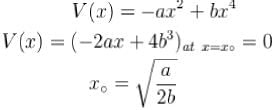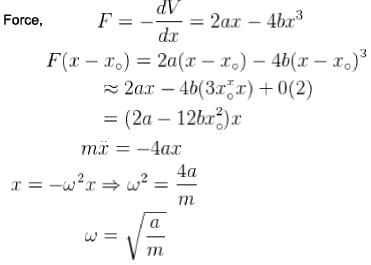Physics Exam > Physics Questions > A particle of mass m moves in one dimensional...
Start Learning for Free
A particle of mass m moves in one dimensional pote
ntial v(x)=-ax2+ bx4where a and b are positive constants. What is the angular frequency of small oscillationsabout the minimum of the potential in units of root a/m.
Correct answer is '2'. Can you explain this answer?
| FREE This question is part of | Download PDF Attempt this Test |
Verified Answer
A particle of mass m moves in one dimensional pote... morential v(x)=-...


The correct answer is: 1
Most Upvoted Answer
A particle of mass m moves in one dimensional pote... morential v(x)=-...
Given Information:
A particle of mass m moves in a one-dimensional potential given by v(x) = -ax^2 + bx^4, where a and b are positive constants.
To find:
The angular frequency of small oscillations about the minimum of the potential in units of √(a/m).
Solution:
Step 1: Finding the Minimum of the Potential
To find the minimum of the potential, we need to find the value of x for which the derivative of v(x) with respect to x is equal to zero.
dv(x)/dx = -2ax + 4bx^3
Setting the derivative equal to zero and solving for x:
-2ax + 4bx^3 = 0
2ax = 4bx^3
x(2a - 4bx^2) = 0
x = 0 or x^2 = a/2b
Since a and b are positive constants, the minimum of the potential occurs at x = 0.
Step 2: Taylor Expansion of the Potential
To determine the angular frequency of small oscillations, we can use the Taylor expansion of the potential around the minimum (x = 0).
v(x) = v(0) + (dv/dx)|x=0 * x + (1/2)(d^2v/dx^2)|x=0 * x^2 + ...
The first two terms of the Taylor expansion are sufficient for our calculation.
v(x) = v(0) + (1/2)(d^2v/dx^2)|x=0 * x^2
Since the potential is minimized at x = 0, v(0) = 0.
v(x) = (1/2)(d^2v/dx^2)|x=0 * x^2
Since the potential is given by v(x) = -ax^2 + bx^4, we can find the second derivative:
d^2v/dx^2 = -2a + 12bx^2
Evaluating the second derivative at x = 0:
(d^2v/dx^2)|x=0 = -2a
Step 3: Harmonic Approximation
Using the harmonic approximation, we can write the potential as:
v(x) = (1/2)(d^2v/dx^2)|x=0 * x^2
v(x) = -a * x^2
This is the equation of a simple harmonic oscillator with angular frequency ω = √(a/m).
Step 4: Finding the Angular Frequency in Units of √(a/m)
The angular frequency of the small oscillations is ω = √(a/m).
Since a and m are positive constants, the angular frequency in units of √(a/m) is given by:
ω/(√(a/m)) = √(a/m) / √(a/m) = 1
Therefore, the angular frequency of small oscillations about the minimum of the potential in units of √(a/m) is 2.
A particle of mass m moves in a one-dimensional potential given by v(x) = -ax^2 + bx^4, where a and b are positive constants.
To find:
The angular frequency of small oscillations about the minimum of the potential in units of √(a/m).
Solution:
Step 1: Finding the Minimum of the Potential
To find the minimum of the potential, we need to find the value of x for which the derivative of v(x) with respect to x is equal to zero.
dv(x)/dx = -2ax + 4bx^3
Setting the derivative equal to zero and solving for x:
-2ax + 4bx^3 = 0
2ax = 4bx^3
x(2a - 4bx^2) = 0
x = 0 or x^2 = a/2b
Since a and b are positive constants, the minimum of the potential occurs at x = 0.
Step 2: Taylor Expansion of the Potential
To determine the angular frequency of small oscillations, we can use the Taylor expansion of the potential around the minimum (x = 0).
v(x) = v(0) + (dv/dx)|x=0 * x + (1/2)(d^2v/dx^2)|x=0 * x^2 + ...
The first two terms of the Taylor expansion are sufficient for our calculation.
v(x) = v(0) + (1/2)(d^2v/dx^2)|x=0 * x^2
Since the potential is minimized at x = 0, v(0) = 0.
v(x) = (1/2)(d^2v/dx^2)|x=0 * x^2
Since the potential is given by v(x) = -ax^2 + bx^4, we can find the second derivative:
d^2v/dx^2 = -2a + 12bx^2
Evaluating the second derivative at x = 0:
(d^2v/dx^2)|x=0 = -2a
Step 3: Harmonic Approximation
Using the harmonic approximation, we can write the potential as:
v(x) = (1/2)(d^2v/dx^2)|x=0 * x^2
v(x) = -a * x^2
This is the equation of a simple harmonic oscillator with angular frequency ω = √(a/m).
Step 4: Finding the Angular Frequency in Units of √(a/m)
The angular frequency of the small oscillations is ω = √(a/m).
Since a and m are positive constants, the angular frequency in units of √(a/m) is given by:
ω/(√(a/m)) = √(a/m) / √(a/m) = 1
Therefore, the angular frequency of small oscillations about the minimum of the potential in units of √(a/m) is 2.

|
Explore Courses for Physics exam
|

|
A particle of mass m moves in one dimensional pote... morential v(x)=-ax2+ bx4where a and b are positive constants. What is the angular frequency of small oscillationsabout the minimum of the potential in units of root a/m.Correct answer is '2'. Can you explain this answer?
Question Description
A particle of mass m moves in one dimensional pote... morential v(x)=-ax2+ bx4where a and b are positive constants. What is the angular frequency of small oscillationsabout the minimum of the potential in units of root a/m.Correct answer is '2'. Can you explain this answer? for Physics 2024 is part of Physics preparation. The Question and answers have been prepared according to the Physics exam syllabus. Information about A particle of mass m moves in one dimensional pote... morential v(x)=-ax2+ bx4where a and b are positive constants. What is the angular frequency of small oscillationsabout the minimum of the potential in units of root a/m.Correct answer is '2'. Can you explain this answer? covers all topics & solutions for Physics 2024 Exam. Find important definitions, questions, meanings, examples, exercises and tests below for A particle of mass m moves in one dimensional pote... morential v(x)=-ax2+ bx4where a and b are positive constants. What is the angular frequency of small oscillationsabout the minimum of the potential in units of root a/m.Correct answer is '2'. Can you explain this answer?.
A particle of mass m moves in one dimensional pote... morential v(x)=-ax2+ bx4where a and b are positive constants. What is the angular frequency of small oscillationsabout the minimum of the potential in units of root a/m.Correct answer is '2'. Can you explain this answer? for Physics 2024 is part of Physics preparation. The Question and answers have been prepared according to the Physics exam syllabus. Information about A particle of mass m moves in one dimensional pote... morential v(x)=-ax2+ bx4where a and b are positive constants. What is the angular frequency of small oscillationsabout the minimum of the potential in units of root a/m.Correct answer is '2'. Can you explain this answer? covers all topics & solutions for Physics 2024 Exam. Find important definitions, questions, meanings, examples, exercises and tests below for A particle of mass m moves in one dimensional pote... morential v(x)=-ax2+ bx4where a and b are positive constants. What is the angular frequency of small oscillationsabout the minimum of the potential in units of root a/m.Correct answer is '2'. Can you explain this answer?.
Solutions for A particle of mass m moves in one dimensional pote... morential v(x)=-ax2+ bx4where a and b are positive constants. What is the angular frequency of small oscillationsabout the minimum of the potential in units of root a/m.Correct answer is '2'. Can you explain this answer? in English & in Hindi are available as part of our courses for Physics.
Download more important topics, notes, lectures and mock test series for Physics Exam by signing up for free.
Here you can find the meaning of A particle of mass m moves in one dimensional pote... morential v(x)=-ax2+ bx4where a and b are positive constants. What is the angular frequency of small oscillationsabout the minimum of the potential in units of root a/m.Correct answer is '2'. Can you explain this answer? defined & explained in the simplest way possible. Besides giving the explanation of
A particle of mass m moves in one dimensional pote... morential v(x)=-ax2+ bx4where a and b are positive constants. What is the angular frequency of small oscillationsabout the minimum of the potential in units of root a/m.Correct answer is '2'. Can you explain this answer?, a detailed solution for A particle of mass m moves in one dimensional pote... morential v(x)=-ax2+ bx4where a and b are positive constants. What is the angular frequency of small oscillationsabout the minimum of the potential in units of root a/m.Correct answer is '2'. Can you explain this answer? has been provided alongside types of A particle of mass m moves in one dimensional pote... morential v(x)=-ax2+ bx4where a and b are positive constants. What is the angular frequency of small oscillationsabout the minimum of the potential in units of root a/m.Correct answer is '2'. Can you explain this answer? theory, EduRev gives you an
ample number of questions to practice A particle of mass m moves in one dimensional pote... morential v(x)=-ax2+ bx4where a and b are positive constants. What is the angular frequency of small oscillationsabout the minimum of the potential in units of root a/m.Correct answer is '2'. Can you explain this answer? tests, examples and also practice Physics tests.

|
Explore Courses for Physics exam
|

|
Suggested Free Tests
Signup for Free!
Signup to see your scores go up within 7 days! Learn & Practice with 1000+ FREE Notes, Videos & Tests.
















